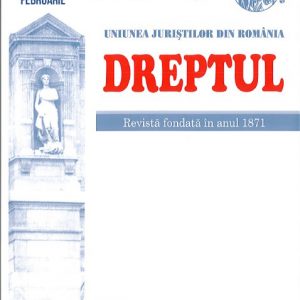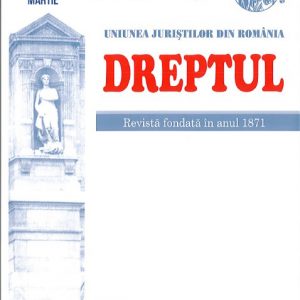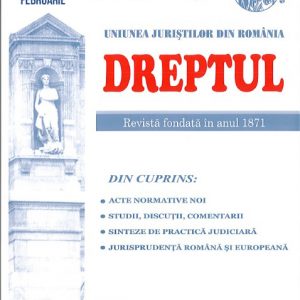-
 Aspecte introductive. Dispozițiile legale vizate direct de conținutul Deciziei Curții Constituționale nr. 405/20161 sunt art. 246 din Codul penal anterior și art. 297 din Codul penal în vigoare. Conform art. 246 din Codul penal din 1969: „Fapta funcționarului public, care, în exercițiul atribuțiilor sale de serviciu, cu știință, nu îndeplinește un act ori îl îndeplinește în mod defectuos și prin aceasta cauzează o vătămare intereselor legale ale unei persoane se pedepsește cu închisoare de la 6 luni la 3 ani.”
Aspecte introductive. Dispozițiile legale vizate direct de conținutul Deciziei Curții Constituționale nr. 405/20161 sunt art. 246 din Codul penal anterior și art. 297 din Codul penal în vigoare. Conform art. 246 din Codul penal din 1969: „Fapta funcționarului public, care, în exercițiul atribuțiilor sale de serviciu, cu știință, nu îndeplinește un act ori îl îndeplinește în mod defectuos și prin aceasta cauzează o vătămare intereselor legale ale unei persoane se pedepsește cu închisoare de la 6 luni la 3 ani.” -
 Practica judiciară recentă s-a confruntat cu numeroase frământări în legătură cu îndeplinirea elementelor constitutive ale infracțiunii de abuz în serviciu, prevăzută în art. 297 C.pen. Potrivit acestui articol, constituie infracțiunea de abuz în serviciu „fapta funcționarului public care, în exercitarea atribuțiilor de serviciu, nu îndeplinește un act sau îl îndeplinește în mod defectuos și prin aceasta cauzează o pagubă ori o vătămare a drepturilor sau intereselor legitime ale unei persoane fizice sau ale unei persoane juridice”
Practica judiciară recentă s-a confruntat cu numeroase frământări în legătură cu îndeplinirea elementelor constitutive ale infracțiunii de abuz în serviciu, prevăzută în art. 297 C.pen. Potrivit acestui articol, constituie infracțiunea de abuz în serviciu „fapta funcționarului public care, în exercitarea atribuțiilor de serviciu, nu îndeplinește un act sau îl îndeplinește în mod defectuos și prin aceasta cauzează o pagubă ori o vătămare a drepturilor sau intereselor legitime ale unei persoane fizice sau ale unei persoane juridice” -
 Abuzul în serviciu este reglementat în Codul penal în vigoare ca una dintre infracțiunile de serviciu în art. 297 C.pen. El nu reprezintă o noutate legislativă, având corespondent în art. 246–2481 C.pen. 1969. Se poate afirma astfel că, deși comportamentul corespunzător tipicității infracțiunii de abuz în serviciu avea reflectare în legislație de foarte multă vreme, nu au fost constatate de-a lungul activității normelor de incriminare aspecte de neconstituționalitate. Cu toate acestea, prin Decizia nr. 405/20161, Curtea Constituțională a României a constatat următoarele: caracterul neconstituțional al prevederii din art. 297 C.pen., precum și al celei din art. 246 C.pen. 1969 încalcă prevederile constituționale ale art. 1 alin. (5), întrucât sintagma „îndeplinește în mod defectuos” nu prevede în mod expres elementul în legătură cu care defectuozitatea este analizată2.
Abuzul în serviciu este reglementat în Codul penal în vigoare ca una dintre infracțiunile de serviciu în art. 297 C.pen. El nu reprezintă o noutate legislativă, având corespondent în art. 246–2481 C.pen. 1969. Se poate afirma astfel că, deși comportamentul corespunzător tipicității infracțiunii de abuz în serviciu avea reflectare în legislație de foarte multă vreme, nu au fost constatate de-a lungul activității normelor de incriminare aspecte de neconstituționalitate. Cu toate acestea, prin Decizia nr. 405/20161, Curtea Constituțională a României a constatat următoarele: caracterul neconstituțional al prevederii din art. 297 C.pen., precum și al celei din art. 246 C.pen. 1969 încalcă prevederile constituționale ale art. 1 alin. (5), întrucât sintagma „îndeplinește în mod defectuos” nu prevede în mod expres elementul în legătură cu care defectuozitatea este analizată2. -
 Curtea Constituțională a fost sesizată cu excepția de neconstituționalitate ridicată de un număr mare de funcționari publici trimiși în judecată pentru săvârșirea infracțiunii de abuz în serviciu, care a fost reglementată de art. 246 din Codul penal din 19691, având conținutul „Fapta funcționarului public, care, în exercițiul atribuțiilor de serviciu, cu știință, nu îndeplinește un act ori îl îndeplinește în mod defectuos și prin aceasta cauzează o vătămare intereselor legale ale unei persoane se pedepsește cu închisoare de la 6 luni la 3 ani”, precum și de art. 297 alin. (1) din Codul penal în vigoare, adoptat în anul 2009, potrivit căruia „Fapta funcționarului public care, în exercitarea atribuțiilor de serviciu, nu îndeplinește un act sau îl îndeplinește în mod defectuos și prin aceasta cauzează o pagubă ori o vătămare a drepturilor sau intereselor legitime ale unei persoane fizice sau ale unei persoane juridice se pedepsește cu închisoare de la 2 la 7 ani și interzicerea exercitării dreptului de a ocupa o funcție publică.”
Curtea Constituțională a fost sesizată cu excepția de neconstituționalitate ridicată de un număr mare de funcționari publici trimiși în judecată pentru săvârșirea infracțiunii de abuz în serviciu, care a fost reglementată de art. 246 din Codul penal din 19691, având conținutul „Fapta funcționarului public, care, în exercițiul atribuțiilor de serviciu, cu știință, nu îndeplinește un act ori îl îndeplinește în mod defectuos și prin aceasta cauzează o vătămare intereselor legale ale unei persoane se pedepsește cu închisoare de la 6 luni la 3 ani”, precum și de art. 297 alin. (1) din Codul penal în vigoare, adoptat în anul 2009, potrivit căruia „Fapta funcționarului public care, în exercitarea atribuțiilor de serviciu, nu îndeplinește un act sau îl îndeplinește în mod defectuos și prin aceasta cauzează o pagubă ori o vătămare a drepturilor sau intereselor legitime ale unei persoane fizice sau ale unei persoane juridice se pedepsește cu închisoare de la 2 la 7 ani și interzicerea exercitării dreptului de a ocupa o funcție publică.” -
 Nu există vreun temei pentru a crea o ordine de preferință a declarațiilor, în sensul reținerii celor date în faza de judecată, în detrimentul celor date în faza de urmărire. Principiul liberei aprecieri a probelor nu permite distincția dintre probele administrate în faza de urmărire și cele administrate în faza de judecată și se opune ca cele din urmă să fie luate în considerare în detrimentul celor dintâi, numai pe criteriul fazei procesuale în care au fost obținute. Singurul criteriu care trebuie avut în vedere atunci când o probă este fie reținută pentru a contura o situație de fapt, fie înlăturată din ansamblul tuturor probelor existente în dosar este cel al coroborării probei în discuție cu celelalte probe administrate.
Nu există vreun temei pentru a crea o ordine de preferință a declarațiilor, în sensul reținerii celor date în faza de judecată, în detrimentul celor date în faza de urmărire. Principiul liberei aprecieri a probelor nu permite distincția dintre probele administrate în faza de urmărire și cele administrate în faza de judecată și se opune ca cele din urmă să fie luate în considerare în detrimentul celor dintâi, numai pe criteriul fazei procesuale în care au fost obținute. Singurul criteriu care trebuie avut în vedere atunci când o probă este fie reținută pentru a contura o situație de fapt, fie înlăturată din ansamblul tuturor probelor existente în dosar este cel al coroborării probei în discuție cu celelalte probe administrate. -
 This study appeared as a result of a case solved in practice and identifies legal issues also common to many other cases, which, as always, is subject to the analysis and to the specialised criticism, the latter being accompanied by any other possible points of view.
This study appeared as a result of a case solved in practice and identifies legal issues also common to many other cases, which, as always, is subject to the analysis and to the specialised criticism, the latter being accompanied by any other possible points of view. -
 By the provisions of the Law No 122/2006 on asylum in Romania, as amended and supplemented, the legislator has chosen to derogate from the provisions of common law in the matter of recourse with regard to the time when it starts to run, having as starting point the moment when the judgment of the first instance court was pronounced, without having in view the presence or absence of the party concerned, as well as without taking into consideration the special situation of the asylum seekers from Romania, foreign citizens or stateless persons, most of them not speaking Romanian. This study intends to emphasize how, by this derogation from the processual civil provisions which represent the common law in the matter, it is violated the free access to justice established by the provisions of Article 21 of the Constitution of Romania, supporting the running of the time limit for recourse from the time of communication of the judgment of the court of first instance, and not from the time of pronouncement.
By the provisions of the Law No 122/2006 on asylum in Romania, as amended and supplemented, the legislator has chosen to derogate from the provisions of common law in the matter of recourse with regard to the time when it starts to run, having as starting point the moment when the judgment of the first instance court was pronounced, without having in view the presence or absence of the party concerned, as well as without taking into consideration the special situation of the asylum seekers from Romania, foreign citizens or stateless persons, most of them not speaking Romanian. This study intends to emphasize how, by this derogation from the processual civil provisions which represent the common law in the matter, it is violated the free access to justice established by the provisions of Article 21 of the Constitution of Romania, supporting the running of the time limit for recourse from the time of communication of the judgment of the court of first instance, and not from the time of pronouncement. -
 This article inspired us by the following situation existing in the legislation and doctrine: The law on county councils does not contain edifying referrals to specific procedures for approving the minutes of county councils meetings (we find also a quasi-similar situation regarding the minutes’ records challenge in court); The doctrine which should have filled this gap is inexistent and is limited to making referrals to other aspects of the minutes, taken from legislation, legislation which, as already mentioned, is extremely vague on this matter; The lack of an administrative procedure code leaves unclear this side of the concrete way for the minutes’ approval. Therefore, starting from the unequal practice of local authorities on the minutes’ approval in court, we shall try, through the arguments in this article, to come to support practitioners in local government and, why not, to also offer a source of inspiration in drafting the Administrative Procedure Code.
This article inspired us by the following situation existing in the legislation and doctrine: The law on county councils does not contain edifying referrals to specific procedures for approving the minutes of county councils meetings (we find also a quasi-similar situation regarding the minutes’ records challenge in court); The doctrine which should have filled this gap is inexistent and is limited to making referrals to other aspects of the minutes, taken from legislation, legislation which, as already mentioned, is extremely vague on this matter; The lack of an administrative procedure code leaves unclear this side of the concrete way for the minutes’ approval. Therefore, starting from the unequal practice of local authorities on the minutes’ approval in court, we shall try, through the arguments in this article, to come to support practitioners in local government and, why not, to also offer a source of inspiration in drafting the Administrative Procedure Code. -
 In this article the author defines the judicial security and analyzes its role within the national security system, but also the relations between the judiciary system and the national security system.
In this article the author defines the judicial security and analyzes its role within the national security system, but also the relations between the judiciary system and the national security system. -
 The following article analyzes mediation procedure implemented in the Romanian law system by the Law No 192/2006 on the mediation and on the organization of the profession of mediator. The paper makes a critical assessment of the problems encountered in implementing mediation procedure in the cases generated by the public administration activity. It also presents the jurisprudence of the Romanian Court of Accounts on this subject.
The following article analyzes mediation procedure implemented in the Romanian law system by the Law No 192/2006 on the mediation and on the organization of the profession of mediator. The paper makes a critical assessment of the problems encountered in implementing mediation procedure in the cases generated by the public administration activity. It also presents the jurisprudence of the Romanian Court of Accounts on this subject. -
 The article addresses in a systematized manner some of the most important problems raised in the administrative practice and, implicitly, in the case law of the administrative disputes courts by the traditional triad concerning the cessation of producing of legal effects by the administrative acts, namely the nullity, revocation and inexistence. There are briefly reviewed aspects concerning terminology, doctrinal definitions, the relative nullity – absolute nullity distinction in the administrative law, the legality – opportunity correlation from the perspective of the control of administrative acts, the authorities competent to establish the nullity, revocation or inexistence of an administrative act. The complex issue of the legal effects of finding the nullity, the revocation or inexistence of administrative acts, but also of the repeal that can intervene only in case of normative administrative acts is examined by reference to some of the relevant solutions of the administrative case law. A newly raised issue, due to the incidence of the administrative law, briefly aims at the position of prosecutor of case or of judge in relation to an administrative act with incidence in a criminal case.
The article addresses in a systematized manner some of the most important problems raised in the administrative practice and, implicitly, in the case law of the administrative disputes courts by the traditional triad concerning the cessation of producing of legal effects by the administrative acts, namely the nullity, revocation and inexistence. There are briefly reviewed aspects concerning terminology, doctrinal definitions, the relative nullity – absolute nullity distinction in the administrative law, the legality – opportunity correlation from the perspective of the control of administrative acts, the authorities competent to establish the nullity, revocation or inexistence of an administrative act. The complex issue of the legal effects of finding the nullity, the revocation or inexistence of administrative acts, but also of the repeal that can intervene only in case of normative administrative acts is examined by reference to some of the relevant solutions of the administrative case law. A newly raised issue, due to the incidence of the administrative law, briefly aims at the position of prosecutor of case or of judge in relation to an administrative act with incidence in a criminal case. -
 In this article the author analyzes the constitutional text (Article 83 of the Basic Law) which sets the duration of the term of office of the President of Romania. The problem of setting the duration of the term of office of the President of Republic is both a legal problem and a political one, whereas, in terms of electing the President of Romania by direct universal vote, it has a legitimacy equal to that of the Parliament, which confers it the vocation to aspire to an enhanced executive power, in which case it may enter into cohabitation relations with the Government supported by a parliamentary majority hostile to the President of Republic. The author brings into discussion for the first time in the specialised literature and on the basis of the documents of the Constituent Assembly, existing in the Archive of the Senate of Romania, the duration of the five-year term of office of the President, forecast by the Commission for drafting of the Constitution and included in the original form of the Theses suggested by the Commission to the Constituent Assembly. Following the parliamentary debate, the constituent legislators reduced the five-year term of office of the President of Romania to four years. Following the constitutional revision in 2003, the five-year presidential term of office is restored starting from 2009.
In this article the author analyzes the constitutional text (Article 83 of the Basic Law) which sets the duration of the term of office of the President of Romania. The problem of setting the duration of the term of office of the President of Republic is both a legal problem and a political one, whereas, in terms of electing the President of Romania by direct universal vote, it has a legitimacy equal to that of the Parliament, which confers it the vocation to aspire to an enhanced executive power, in which case it may enter into cohabitation relations with the Government supported by a parliamentary majority hostile to the President of Republic. The author brings into discussion for the first time in the specialised literature and on the basis of the documents of the Constituent Assembly, existing in the Archive of the Senate of Romania, the duration of the five-year term of office of the President, forecast by the Commission for drafting of the Constitution and included in the original form of the Theses suggested by the Commission to the Constituent Assembly. Following the parliamentary debate, the constituent legislators reduced the five-year term of office of the President of Romania to four years. Following the constitutional revision in 2003, the five-year presidential term of office is restored starting from 2009.
